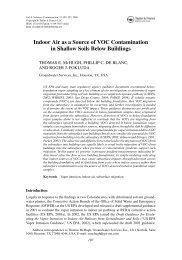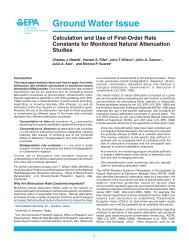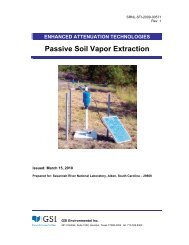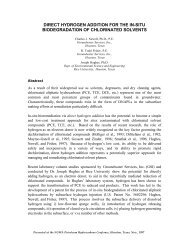Parameter Estimation Guidelines for Risk-Based Corrective Action ...
Parameter Estimation Guidelines for Risk-Based Corrective Action ...
Parameter Estimation Guidelines for Risk-Based Corrective Action ...
You also want an ePaper? Increase the reach of your titles
YUMPU automatically turns print PDFs into web optimized ePapers that Google loves.
TABLE 4. PARAMETER SELECTION GUIDELINES: LATERAL AIR TRANSPORT MODEL (EQUATION LT-2)<br />
Input <strong>Parameter</strong><br />
Symbol Description Typical Range <strong>Parameter</strong> Measurement or <strong>Estimation</strong> <strong>Guidelines</strong> Reference<br />
SITE-SPECIFIC PARAMETER MEASUREMENTS<br />
L<br />
Length of affected soil zone parallel to wind direction<br />
(cm)<br />
Site-specific<br />
Determine lateral extent of affected soil zone serving as source of<br />
vapor release (e.g., zone exceeding Tier 1 limits) measured along line<br />
passing from source zone to downwind off-site POE.<br />
Connor et al, 1995<br />
A Lateral area of affected soil zone (cm 2 ) Site-specific Measure areal extent of affected soils serving as source of vapor<br />
release (e.g., zone exceeding Tier 1 limits).<br />
Connor et al, 1995<br />
X Lateral distance downwind of source zone (cm) Site-specific For most conservative evaluation, measure as distance from edge of<br />
affected soil zone to nearest off-site POE location (in some direction as<br />
L above). For typical case, measure this distance along line of<br />
predominant annual wind direction.<br />
Connor et al, 1995<br />
REASONABLE PARAMETER ESTIMATES<br />
U air Windspeed above ground surface in ambient mixing 45 - 450 cm/sec Match to average annual windspeed <strong>for</strong> site area, based on published Connor et al, 1995<br />
zone (cm/s)<br />
climatic data.<br />
δ air Ambient air mixing zone height (cm/s) 200 cm Match to typical height of human breathing zone (6 ft or 2m). ASTM, 1995<br />
y Transverse distance off air plume centerline (cm) ----- To evaluate exposure concentrations along plume centerline, y is set Connor et al, 1995<br />
equal to zero.<br />
z height of breathing zone (cm) ----- Assume equal to δ air above. Connor et al, 1995<br />
σ y , σ z<br />
C si<br />
NOTE:<br />
Air dispersion coefficients (cm) in the transverse (y)<br />
and vertical (z) directions<br />
Concentration of constituent i in ambient air at point<br />
source<br />
----- For average annual climatic conditions, characterize σ y , σ z based on<br />
Stability Class C (slightly unstable) using the following relationships:<br />
σ y = 10 (Log (x)• 0.941 - 0.861)<br />
σ z = 10 (Log (x)• 0.927 - 1.01)<br />
If Stability Class C determined to be inapplicable, estimate air<br />
dispersion coefficient values using Pasquill-Gif<strong>for</strong>d system as discussed<br />
in DeVaull et al, 1994.<br />
----- Estimate based on appropriate soil-to-air volatilization model (see<br />
Equations CM-1 through CM-3 on Figure 2) or conduct site-specific<br />
measurements in breathing zone air overlying affected soil source<br />
area.<br />
Connor et al, 1995<br />
Devaull et al, 1994<br />
U.S. EPA, 1988<br />
Connor et al, 1995<br />
See Equation LT-2 on Figure 3 regarding use of the above parameters <strong>for</strong> estimation of lateral air dispersion factor <strong>for</strong> wind-borne contaminant transport to downwind receptor.<br />
Detailed discussion of this air dispersion model is provided in the Tier 2 RBCA Guidance Manual (see Connor et al, 1995).<br />
NGWA Petroleum Hydrocarbons Conference 19 <strong>Parameter</strong> <strong>Estimation</strong> <strong>Guidelines</strong><br />
Houston, Texas, November 1996<br />
<strong>for</strong> RBCA Modeling






